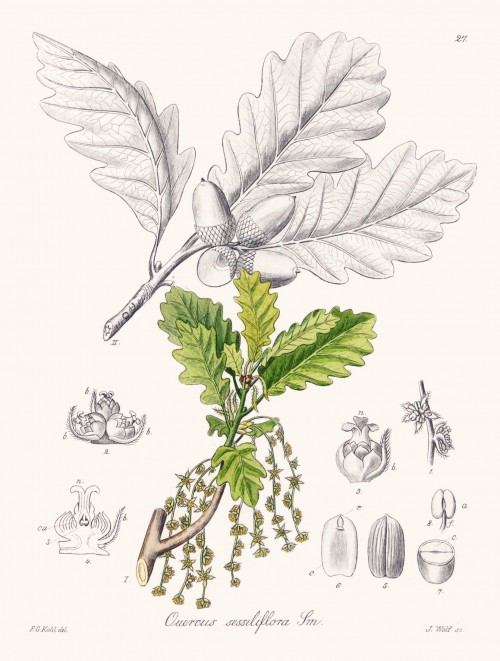Dies ist eine alte Version des Dokuments!
Quercus petraea (Matt.) Liebl. - syn. Quercus sessilis Ehrh.; Quercus sessiliflora Salisb. - Fagaceae
sessile oak, Irish oak, Welsh oak, Cornish oak, Durmast oak, Traubeneiche, Wintereiche, Steineiche
Deciduous monoecious tree, up to 35m high, native to Europe, West Asia; leaves 7-14cm long, petioled 1-3cm, evenly lobed; male inflorescence pendulous, up to 6cm long; female inflorescences in leaf axils, flowers in stalkless clusters of 2-5; fruit an acorn 2-3cm long.
„Seedlings of Q. petraea may be more shade-tolerant than those of Q. robur and is therefore more able to regenerate in woodland.“
[Quercus petraea (Sessile Oak), Online Atlas of the British and Irish flora] http://www.brc.ac.uk/plantatlas/index.php?q=plant/unmatched-species-name-250
The proantho-cyanidins isolated from oak bark (Quercus petraea) „…had an average polymerization degree of 6.1 and a procyanidin: prodelphinidin ratio of 6:4. The prevailing units of the oligomeric chains were (+)-catechin, (-)-epicatechin, and (+)-gallocatechin, minor units were (-)-epicatechin 3- O-gallate and (-)-epigallocatechin 3- O-gallate. The bark contains both hydrolyzable and condensed tannins. Although only 23% of the water-soluble oak bark tannins consisted of oligomeric proanthocyanidins, these contributed with 55% to the astringency of the total tannin fraction.“
[Proanthocyanidins from Quercus petraea Bark., Pallenbach, E., Scholz, E., König, M., Rimpler, H., Planta medica, 59(3), 1993, 264-268]
The bark contained th ellagitannins 2,3-(S)-hexahydroxydiphenoyl-glucose, pedunculagin, vescalagin, and castalagin; the flavanoellagitannins acutissimin A, acutissimin B, eugenigrandin A, guajavin B, and stenophyllanin C; and the procyanidinoellagitannin.
[Ellagitannins and complex tannins from Quercus petraea bark., König, M., Scholz, E., Hartmann, R., Lehmann, W., Rimpler, H., Journal of natural products, 57(10), 1994, 1411-1415]
The dried bark of young trees of Q.petraea and Q.robur (oak bark, Quercus cortex, Cortex Quercus, Eichenrinde) is used as decocotion internally against diarrhoea, externally against inflammations of the skin or mucosa, particularly of the genital and anal region (as sitting bath).
[Hagers Handbuch der Pharmazeutischen Praxis, Springer 2010]

Quercus petraea (Matt.) Liebl. as Quercus sessiliflora Salisb.
Kohl,F.G., Die officinellen Pflanzen der Pharmacopoea Germanica, t.27 (1891-1895)
http://plantgenera.org/species.php?id_species=861250
